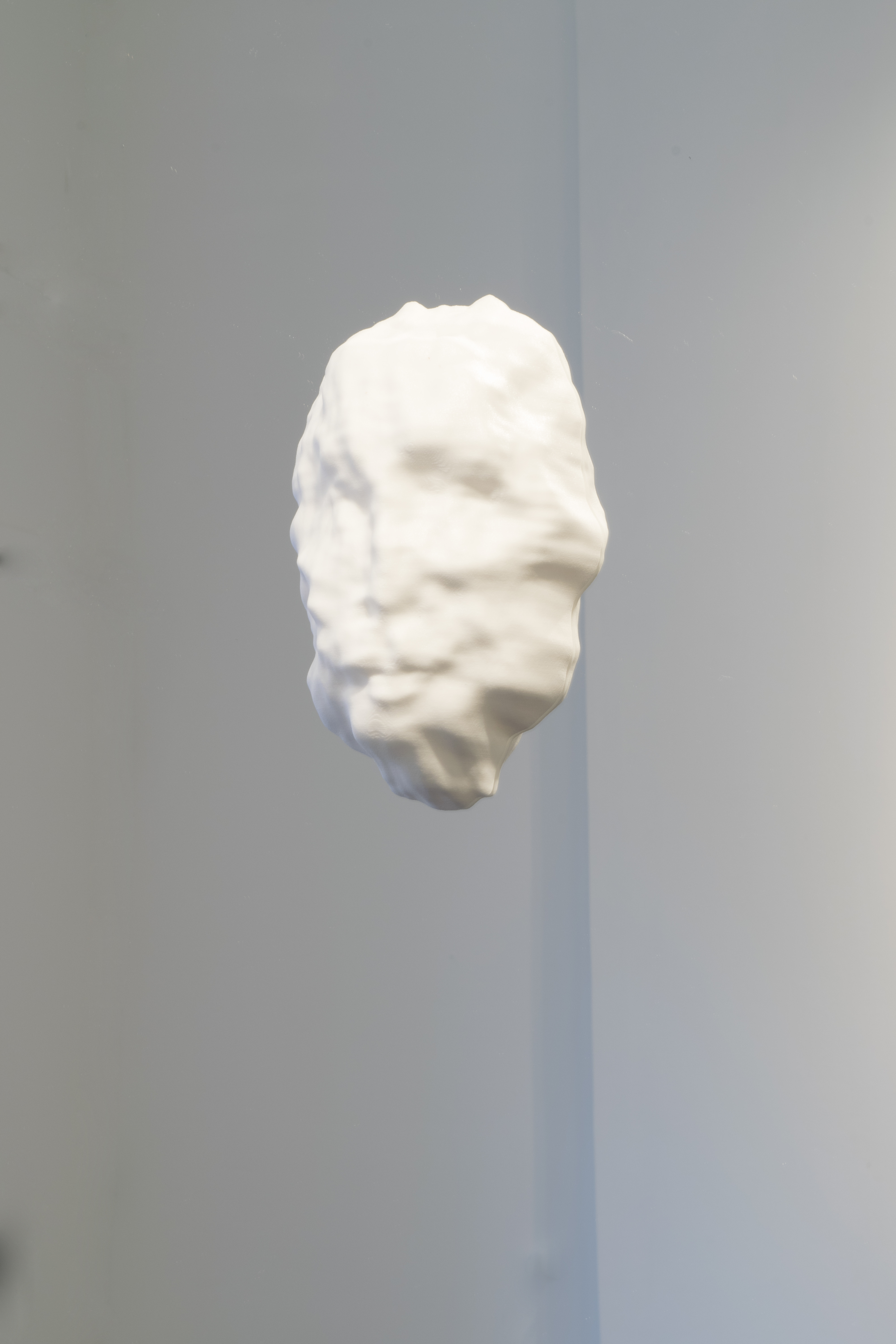MAINSPACE EXHIBITION /

The logo for Derek Curry & Jennifer Gradecki’s project, ‘Crowd-Sourced Intelligence Agency: Agent Bayes’ (2015).
Surveillance
Sterling Crispin, Jennifer Gradecki & Derek Curry, Maggie Flynn, Mathieu Lambert, Jillian Mayer, and Genevieve Robertson & Jay White
October 17 – November 14, 2015
Surveillance features works by: Sterling Crispin, Derek Curry & Jennifer Gradecki, Maggie Flynn, Mathieu Lambert, Jillian Mayer, and Genevieve Robertson & Jay White. This group exhibition focuses on the effect surveillance has on privacy and personal independence. Surveillance has been an increasingly omnipresent force in North American culture. A social expectancy and understanding that we will be watched in some capacity has formed. Physically and digitally, a person’s actions are monitored, and the question of whether or not that is harmful to one’s existence arises. The exhibiting artists will present works which explore the social and political mechanisms and structures that create surveillance states.
Essay:
Interrupt, intercept, investigate, interrogate
Surveillance and security have become twinned discourses in Canada, where one is rarely discussed without invoking the necessity and urgency of the other. National security is often used as the de facto rationale for the widespread collection of personal data from law-abiding citizens, and as mass surveillance technology grows increasingly sophisticated and refined, fear mongering around public security has increased in tandem.
With the rapid introduction and passing of Bill C-51 in Canadian Parliament, and its signing into law as the Anti-Terrorism Act in June, 2015, the Canadian government and related agencies now have much broader powers to collect and share the personal data of citizens across government departments with little oversight, to interpret what constitutes terrorist propaganda based on vague and indeterminate language, and to make suspicion-based, preventative arrests without warrants. What this amounts to is a demand that the body of the state be secured in the name of the body of the individual. But to who is this security of body directed, and whose bodies will be the focus of protection? The bill has been widely criticized for the ways that it could be unevenly and punitively applied to those visible to the state as non-white, as Indigenous, as activists, as protesters, or those who are deemed threatening by their participation in specific cultures or religions. Artists of all kinds, whose work depends on the production of a specific form of visibility through the presentation of their work, have reason for similar concern.
The irony of our contemporary condition is that the type of sweeping, mass surveillance engaged in by governments and corporations occurs at a level that is necessarily invisible to the public, even though surveillance of any type is predicated on making visible, or exposing, its subjects. This marks a shift from earlier regimes that relied upon our visual awareness of the tools used for policing, for example through deterrent devices like the CCTV camera or watchtower. Behavior in public space was, and continues to be, modified by the knowledge that with every use of an ATM or stroll through a public square or visit to a civic building, we can see the cameras looking back at us and are simultaneously made visible to them. This is the classic model of the panopticon, famously designed by Jeremy Bentham and theorized by Michel Foucault: we see the apparatus and we know its potential to see us, which transforms us into its obedient subjects. The panoptic model of surveillance is built on this mutual visibility. But the contemporary model of surveillance is structured almost entirely upon the opaque realm of data and computer coding hidden within our devices. Information replaces the watchful eye as the central metaphor for power and control in this algorithmic model. To lose control of the wealth of personal information that shapes contemporary subjectivity–the preferences, habits, searches, posts and tastes that form our digital selves–amounts to a kind of exposure that leaves us both extremely visible and vulnerable.
In a discourse about the rights to be made visible and the rights to maintain invisibility, aesthetic practices have much to contribute. Art is so often about revealing society’s frayed social consciousness, about finding a visual language to describe its unseen edges, or to point to the places where it breaks down and disappears completely. For the artists in this exhibition, the urgency of interrogating surveillance and security culture is expressed in works that examine the role of activism, identity politics, social media, personal surveillance, predictive behaviour and non-visual modes of communication. These projects together express the right to be visible on one’s own terms, a right to interrupt and interrogate the underlying power structures that frame mass surveillance as a necessity. As theorist Jasbir Puar has pointed out, “the temporality of surveilling is not just reactive, but also preemptive and increasingly, predictive.”[1] The artists gathered here interrupt this temporality with interventions that offer moments of counter-resistance within the very networks–digital networks, activist networks, social networks–that are implicated in surveillance regimes. However minor such interventions may be, to find resistance within these networks is to acknowledge and respond to one of the most ethical challenges of our time.
— Jayne Wilkinson
[1] Jasbir Puar and Lewis West, “Jasbir Puar: Regimes of Surveillance,” interview, Cosmologics: A Magazine of Science, Religion and Culture. Accessed October 9, 2015. http://cosmologicsmagazine.com/jasbir-puar-regimes-of-surveillance/






Sterling Crispin is an artist and technologist born 1985 in Maui, Hawaii. He addresses technology as both an extension of humanity, and as a distributed life-form pulsing on the surface of the earth with agency and its own agenda. His work investigates the relationships between this exponentially growing techno-organism as it relates to spirituality, human consciousness and impermanence. He received his Master of Fine Arts and Master of Science in Multimedia Engineering from the University of California Santa Barbara. His work has been exhibited in museums and galleries worldwide and has been published in Frieze, Wired, BOMB, Rhizome, Creators Project, Fast Company, Y-Combinator’s Hacker News, and the Post Internet Survival Guide. He was an invited speaker at the first annual Drones and Aerial Robotics Conference in NYC as coauthor of OpenDroneControl, an open source software platform for developing interactive artworks and research projects with aerial robotics. Lectures include NYU ITP, LACMA Art + Technology Lab, SFAQ, YouTube LA, and UCLA Art Sci Center.
Derek Curry & Jennifer Gradecki
Derek Curry’s artistic practice engages questions of agency and knowledge production through a variety of mediums from video games and data analytics, to participatory performance and sculptural data visualizations, and his research focuses on algorithmic modes of control, particularly in the electronic stock exchanges. Jennifer Gradecki’s research and practice focuses on the relationship between information and power, and aims to make specialized knowledge and technical information more accessible. Curry and Gradecki are both currently PhD candidates at SUNY Buffalo, in Media Study and Visual Studies respectively. They earned their MFAs in New Genres from UCLA’s Department of Art in 2010 and have participated in numerous international exhibitions and conferences, including the New Media Gallery in Zadar, the AC Institute in New York, the Science Gallery in Dublin, Critical Finance Studies in Amsterdam, the International Symposium on Electronic Art in Vancouver and Radical Networks at NYU Polytechnic | Eyebeam.
Maggie Flynn is an organizer, artist, and curator. Her version of life/work balance includes a mix of hopeful pragmatism and recreational dancing.
Maggie has presented projects at the Rhubarb Festival, Subtle Technologies, the Art Gallery of York University, the Hemispheric Institute’s Encuentro (Montréal) and Azad Art Gallery (Tehran). Her work also encompasses archiving and research practices which she has spoken about at conferences such as Creative Catalyst (Ryerson University) and This is Paradise (JMB Gallery). Her curatorial work has been shown by VSVSVS, Le Labo, and in her current role as Director of Whippersnapper Gallery.
Mathieu Lambert was born in France in 1986 and currently lives and works in Montreal. He has participated in numerous exhibitions both in Quebec and abroad, most notably at Margate Photo Festival, UK (2011); Triangle Gallery, Philadelphia (2011); Naçao Gallery, Shanghai (2013); Design Terminal, Budapest (2013). His work has been presented in two solo exhibitions in 2015 : Du besoin de transposer at French Restaurant, Montreal and La théorie du complot (Conspiracy theory) at gallery Les Territoires, Montreal. His project Fake Tales of America has recently been published by French Fourch publisher.
Jillian Mayer is an artist and filmmaker living in South Florida.
Mayer’s work explores how technology and the Internet affects our identities, lives and experiences. Through videos, online experiences, photography, telephone numbers, performance, sculpture and installation, her work investigates the tension between physical and digital iterations of identity and existence. Mayer has shown as museums, film festivals, and experimental art venues world wide.
She is a 2015 Creative Capital Awardee and a fellow of the Sundance New Frontier lab.
Genevieve Robertson takes up interdisciplinary strategies to investigate her relationship to specific landscapes. She is invested in durational and cyclical practices that expose the sincerity, longing and felt absurdity of her interface with nature. Robertson’s work is informed by a personal and intergenerational history of resource labor in remote work camps on the west coast of British Columbia.
Genevieve is currently a Master’s Candidate at Emily Carr University of Art and Design and holds a BFA from NSCAD University. She has recently been artist in residence at The Banff Centre and Common Opulence (Alberta), Space 118 (Mumbai), and The Contemporary Artist’s Centre (New York). She has also exhibited with James May Gallery (2015), Milk Glass Co. and the Gladstone Hotel (2014), Space 118 Gallery (2013), Xpace (2011) and the Anna-Leonowens and Khyber Arts Centre (2009).
Jay White is working with and through legal boundaries, the interactions between identities and colonial institutions, and nonhuman entanglements in human projects. Here, unseen and furtive spaces like railway right-of-ways and the edges of waterways become a mysterious and abundant more-than-human Commons where animals, plants, refuse, and people co-exist in non-dominant relations. Through performances and objects, these remote or unseen areas become shared spaces, and people become implicated in reciprocal and embodied relations with the animate entities that surround them.
White’s work has shown worldwide and his films have won various awards internationally, including Best Animated Short at the Worldwide Animation Festival (2010), and a longlist entry for a “Best Animated Short” Academy Award nomination. He has an upcoming solo exhibition in 2016 (at Modern Fuel), and his work has exhibited at the Istanbul Design Biennale (2014), the National Arts Centre (2013) the University of Glasgow (2011), and elsewhere.
